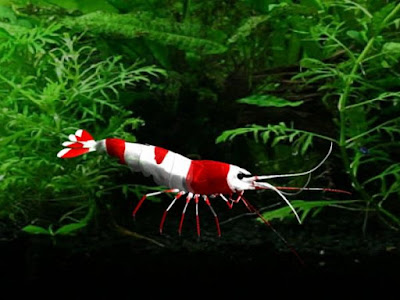Algae Eaters Shrimp Tropical: Ghost Shrimp
Algae
Eaters Shrimp Tropical: Ghost Shrimp –
The most broadly available, and most inexpensive shrimp is the
Ghost Shrimp. While they are much less successful as their Cherry or Amano
brothers, they do a good job at removing hair algae, so they're a god choice
for your own tank if you are suffering from a good deal of that variety.
 |
Photo copyright from theshrimpfarm.com
|
Algae Eaters Shrimp Tropical: Ghost Shrimp
They can be quite small,
usually growing to merely a couple of centimeters in length, plus larger fish
eaten them pretty fast.
In reality, they may be
a precious addition to any tank comprising fish that is small, and help to keep
the tank clean by picking in the bottom of the tank through the detritus and
always eating any food that is missed.
Feeding Ghost Shrimp
Phantom Shrimp will
accept a wide range of foods and are scavenger feeders. They're omnivorous and
certainly will naturally feed on brush algae and fallen food.
Ghost Shrimp can be fed
processed foods such as flakes & pellets. They're generally eaters that are
unfussy. Ghost shrimp have a unique clear body, the food could be seen making
its way during the digestive system. Phantom Shrimp will also eat soft
vegetables and boiled zucchini. Vegetables really are a low cost alternative
and provide the shrimp with vital nutrients.
Housing Phantom Shrimp
Ghost shrimp can
flourish in just about any tank supplied for them and are unbelievably easy to
place. Of course they will do better in bigger tanks, and some may even create
self sustaining populations in heavily planted aquariums.
Tank mates & Compatibility
Ghost Shrimp are best
kept in a species only aquarium or with other really little shrimp species.
They socialize nicely with their particular species, are pretty hardy and breed
fast. They lack defenses that are appropriate to be housed with fish that is larger
and are often used as live feeders.
Mating
The breeding of ghost
shrimp is relatively easy, and also the sole demand is having a sufficient
variety of male and female shrimp. The problem appears since their mouths are
excessively small for normal fish food and most starve to death – at least the
ones that are picked off by hungry fish in keeping the free swimming larvae
living.
After you have put a
pregnant female ghost shrimp in the breeding tank, you then have to tackle the
problem of larval survival. Sadly, as mentioned before, the fry are notoriously
difficult to feed and most fast starve to death. But there has been some
success that is reported by folks using baby brine shrimp or commercially
available fry food.
I have experienced major
success by putting substantial mops of Java moss in the breeding tank for ghost
shrimp, although I have personally never tried both of those alternatives. It
seems to harbor big quantity of infusoria in the tendrils of moss that larvae
to feast on, and I've had an exceptional survival rate for ghost shrimp in just
about any tank with Java moss.
If you are going to keep
ghost shrimp, you should build a place in order for them to conceal, and you
will need to maintain lots of them in case you wish to do some serious damage
with regards to algae management. With their almost see through bodies it’s
simple to determine where Ghost Shrimp get their name from, also. They have
been pleasant to look at, so even though they aren’t the algae eaters that are
best in the tank, they are able to nevertheless be an excellent add-on.



Komentar
Posting Komentar